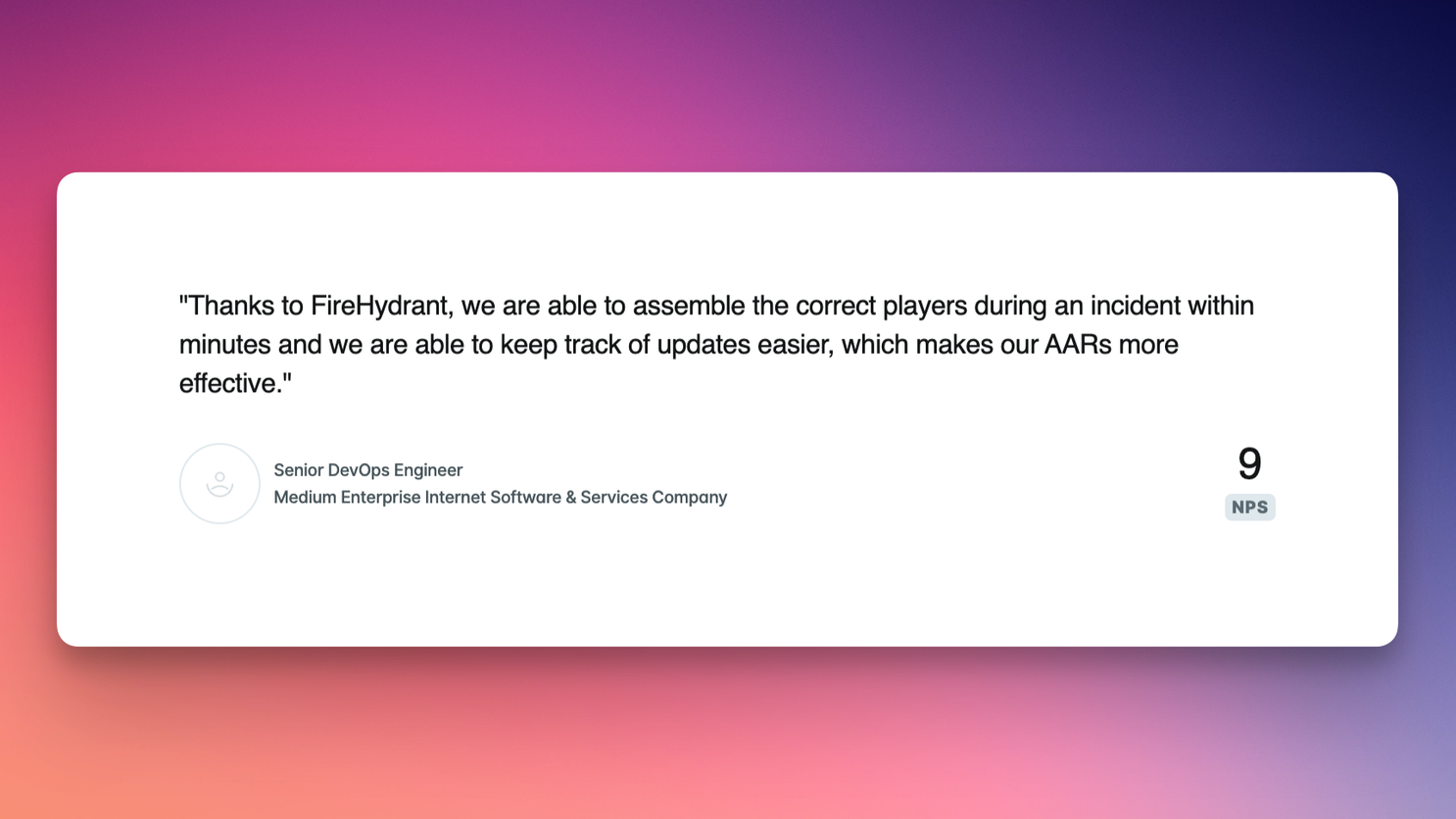210% ROI: unlocking the economic value of FireHydrant for incident management
Analyst firm Enterprise Strategy Group conducted an in-depth evaluation of the costs associated with poor incident management practices and found that FireHydrant reduces the cost of incidents significantly.

In the fast-paced high-tech industry, efficient incident management is a critical factor in maintaining brand reputation, employee morale, and most importantly, your bottom line. Good practices can result in reduced downtime, increased learning opportunities from incidents, and an enhanced reputation among both the engineering community and customers. But quantifying the true cost of incidents has always been a challenge — until now.
The analyst firm Enterprise Strategy Group (ESG) has conducted an in-depth evaluation of the costs associated with poor incident management practices and the benefits of implementing FireHydrant to improve these processes. They found that FireHydrant has been proven to reduce the cost of incidents significantly.
- A robust return on investment of 210%
- A three-year savings of a whopping $4.4 million
- Elimination of assembly time to "virtually zero"
- A short five months to payback on your investment
In this post, I'll dig into more of the nitty gritty, but if you're ready to read the report for yourself, check it out here.
ESG’s comprehensive incident cost analysis#esgs-comprehensive-incident-cost-analysis
For this report, analysts combined qualitative FireHydrant customer interviews with quantitative financial modeling. ESG's model organization is a high-tech company with 5,000 employees, with 1,500 employees forming the engineering team. These engineers build new functionality and support existing code. The organization manages incidents through homegrown tools, costing them 400 hours per year in management, support, and maintenance.
These engineers spend an estimated 0.4% of their time on incidents which results in 13,892 person-hours spent on incident response instead of development annually. This is the cost of lost opportunity.
Customers reported to ESG that using FireHydrant led to accelerated incident declaration and assembly, streamlined incident management, and easier retrospectives. These improvements lead to reduced response times, minimized downtime, and improved customer and employee satisfaction.
For the model organization, ESG found that the 3-year benefit of using FireHydrant amounted to a whopping $4.36 million, with an impressive ROI of 210%. Organizations could achieve significant cost reductions and operational efficiencies by optimizing their incident handling processes with FireHydrant. Let's explore how.
Efficiency gains and reduced costs#efficiency-gains-and-reduced-costs
FireHydrant addresses inefficiencies in incident assembly, handling, and communications. By implementing FireHydrant, organizations can achieve virtually zero assembly time, reduce the number of engineers involved by 20%, and save substantial person-hours.
ESG's analysis also found that FireHydrant reduced SEV1 downtime by 5 hours annually, resulting in a business impact recovery of $642,000. By minimizing the cost associated with unplanned downtime, organizations can maintain smooth operations and protect their bottom line.

Leaving homegrown tools behind#leaving-homegrown-tools-behind
Homegrown incident management tools can have hidden costs. The model organization spent approximately $60,000 per year on a small homegrown application. By adopting FireHydrant, organizations can avoid these costs and benefit from a comprehensive and efficient incident management solution.
Seizing opportunities and accelerating ramp-up#seizing-opportunities-and-accelerating-ramp-up
Unoptimized incident response often leads to diversion of valuable resources from development activities. ESG's analysis revealed that the annual opportunity cost for incident response instead of development was approximately $4.2 million. By implementing FireHydrant, organizations can reduce this lost time by 10%, resulting in an annual benefit of $422,000.

Cultural benefits#cultural-benefits
Turnover in tech can be costly, impacting both productivity and company culture. Organizations using FireHydrant experienced a 5% reduction in voluntary turnover among engineers thanks to the creation of a collaborative, problem-solving environment and improved incident management processes. The reduction amounts to annual savings of $454,000 for the sample organization.
Conclusion#conclusion
ESG's analysis provides compelling evidence of the immense economic value of implementing FireHydrant as an incident management solution. With quantifiable benefits, clear ROI, and a positive cultural impact, FireHydrant is a strategic investment for organizations seeking to optimize their incident management processes and achieve sustainable growth.
Ready to See FireHydrant in Action?
Discover how FireHydrant can revolutionize your incident management and deliver significant ROI for your organization. Start your journey to improved incident management today.